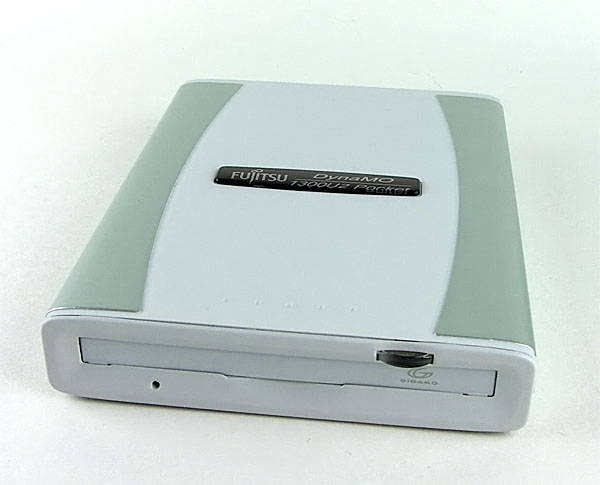
 |
| Home • Reviews • Forums • News 2015 • 2013 • 2012 • 2009 • 2008 • 2007 • 2006 • 2005 • 2004 RSS Feeds • FOV Factor Table • Sensor Sizes | Definitions: A-D • E-H • I-L • M-P • Q-U • V-Z | Sitemap Articles • Archived Websites (Pre-DigitalDingus): D100 Lounge • E-10 Club | Contact |
| Fujitsu DynaMO 1300U2 Pocket |
| Introduction November 20, 2005 |
| Introduction • The 1300U2 • Data Protection • Specifications • Conclusion
|
The Fujitsu 1300U2 Pocket is the more portable version of the DynaMO line. Not requiring an AC adapter, the 1300U2 is powered exclusively by USB cable. The price of the drive is about $80-$100 less than the 2300U2 desktop version. Unlike the 2300U2, it has a maximum capacity of 1.3GB (1.15GB FAT32 formatted) capacity per disk. The 1300U2 is mostly for users who want a proprietary drive for mobile transportation, and don't necessarily need the extra capacity of the 2300U2, but still want to benefit from MO technology at a lower price point.
Gigamo
Giga (GigaByte) + MO (Magneto-Optical) = Gigamo
Magneto-Optical Technology
Basically put, a laser beam (tuned at around 650nm) is projected onto the media disk (made mostly of polycarbonate), where the beam heats a particular layer on the disk to Curie Point (the temperature at which a magnetic substance loses its coercive force, which is 200° C), thereby enabling the magnet within the drive itself to easily contour the polarization of the disk. Once this is done, the drive can quickly switch the polarization of the magnet, creating a data mark on the disk. When reading a disc, the laser beam is polarized and the reflected light is interpreted into data.
1300U2: A Brief History
The 1300U2 is Fujitsu's first Hi-Speed USB2.0 Magneto-Optical drive. On April 16, it was originally demonstrated in Seattle at Microsoft's WinHEC 2002 at the Washington State Convention & Trade Center. On the east coast, it debuted in New York City, June 24, 2002. The 1300U2 was the first drive to have the Gigamo logo, since it was the first to achieve capacities of 1.3 gigabytes.
The major reason why the 1300U2 was created, was due to the medical profession and its requirements. The diagnostic medical imaging industry needed a reliable and yet secure way of transporting a patient's images (ranging from brain scans to ultrasound results) to and from departments, and even to and from hospitals throughout the country and the world.
Many doctors and technicians would just record images to VHS tapes because the patient didn't have access to MO technology at the time. So, for a patient who wanted an ultrasound copy, the doctor would put it on VHS tape most of the time. Now, for highly important images which needed to be saved and reviewed for further testing and analysis, the MO disk was used to retain the data because it was (and still is) the best form of information retention.
Why?
Because your typical 3.5" hard drive does not have a 30-year archival life. The simple truth is, storage technology and retention of that data, is still still in its infancy. We've created much smaller devices and higher data capacities over the decades since IBM's RAMDAC machines which weighed thousands of pounds, but we still haven't mastered a way to retain the data indefinitely.
|
| Home • Reviews • Forums • News 2015 • 2013 • 2012 • 2009 • 2008 • 2007 • 2006 • 2005 • 2004 RSS Feeds • FOV Factor Table • Sensor Sizes | Definitions: A-D • E-H • I-L • M-P • Q-U • V-Z | Sitemap Articles • Archived Websites (Pre-DigitalDingus): D100 Lounge • E-10 Club | Contact |
 You'll see this logo on particular MO products. It means the product is part of the 1 Gigabyte (GB) and higher capacity MO drives, with a 3.5" form factor. Fujitsu developed the drive, while Sony developed the media.
You'll see this logo on particular MO products. It means the product is part of the 1 Gigabyte (GB) and higher capacity MO drives, with a 3.5" form factor. Fujitsu developed the drive, while Sony developed the media.